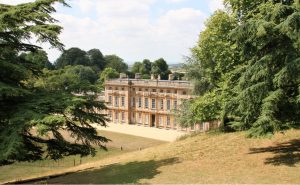I don’t quite know how to go about my second blog but I decided to write about a place that seems to be capturing more of my heart every time I visit. To my way of thinking I haven’t been to a more charming, peaceful or romantic place in all of England or the world. Perhaps I ought to get out more.
I had been to Bath as a youngster but just cannot remember anything about family visits. My memory of my first visit as an adult is of being distinctly underwhelmed by any beauty that the place possessed, but, slowly, mostly as a result of time spent with those who have graced me with their company when visiting, or even when exploring on my own, I have been captivated by its (unique?) charm.
The town’s small and compact footprint is appreciated best of all by standing on one of the surrounding hills which provide a stunning backdrop to this delightful town. Alternatively, a climb to the top of the abbey gives the view from the other direction. It is, without doubt, best explored by foot, allowing one to feel the energy that flows through its streets, its wonderful squares creating a sense of calm amid the excitement popping up elsewhere, usually associated with street performers of various energies and abilities. Every square is surrounded by cafes and restaurants which are normally full, have outside seating for one to feel the buzz in a detached and inactive way. Sit back, and soak up the atmosphere as the world passes by, those pockets of excitement coming from some street entertainment, more often than not a musical player or singer.
My favourite of the many is the main square though finding a suitable place to sit is often a challenge as these popular hotspots can’t cope with the demand. Seating is provided outside, but taking a place means to rely heavily on the British weather which, as Britons often remark, is unpredictable. When the sun is shining, though, it’s great to sit back and appreciate the view of the Abbey and the atmosphere it creates. This results in it becoming the main hub of activity as people flock to admire this fantastic building and the Roman Baths which are located on the edges of this square. I sit, admire the architectural lines and wonder how these buildings were ever created; how much time went into building them; the levels of dedication and devotion required; how they have managed to stand the test of time, etc. By this I mean that some people must have spent their whole lives just building them. As we all marvel at the architecture around us we are joined by street artists and buskers, trying to earn their living from the obliging tourists. They add something very special to this electric atmosphere as these musicians are generally more talented than the wannabees you see on TV. Then there is the bird man; he captures the rats in the sky; and manages to coax them down, his targets being those people so determined to have the perfect Instagram photo.
Drag yourself away from the square and wander towards the river. It is here that the only part of Bath that disappointments – I refer to the iniquity that one is forced to pay to enter Parade Gardens – a travesty. I can’t understand the need to pay to enter, so as a matter of principle I’m left to enjoy the view from the walkway above. After appreciating the gardens on a five minute elevated walk, one follows the path around to get a first view of the famous Pulteney bridge. This iconic bridge, unique and famous just adds to the romance of the town or is it a city? When one walks across it one is blissfully unaware that there is water 15m or so below such is the abundance of shops and cafes to distract. Armed with a camera means that a different view is recorded by shifting a few metres each time and then clicking. Try to freeze the water in the photo as it cascades down the semi-circular weir or, conversely, try to capture moving water by an adjustment to the settings – what joy loaded with a single regret in that a tripod has been left at home. The bridge connects the main town to the Great Pulteney Road, a superb street packed with Georgian buildings, in a straight formation leading to the Holburn museum. The beauty of this house parade is, sadly, spoiled by the large number of cars parked on either side of the street – surely there is another way? Cars are such an important part of modern life but ruin the appearance of this historic and wonderful street.
As mentioned the Holburn Museum sits at the end of the street. Free entry is claimed by the literature although, understandably, a small donation is requested and best to pay as the frowns are palpable. Paying up front was a mistake as, sadly the museum, was wasted on me. I don’t understand art! The museum is situated in Sydney gardens, a small park with not much going for it. On walking through the park, I’m not drawn to anything else other than the fact there is a closed down and abandoned bowls club, a painful reminder of the current issues facing grass roots sport. If this country has more and more elderly people living in it and is struggling to run a bowls club, how are other sports going to survive? We have more and more older people – they can’t all be sitting at home playing computer games.
Upon leaving the park and crossing the railway line, I pick up part of the canal path – well worth the walk -giving spectacular views across the town dominated by the Abbey. Again, only as a result of visiting with someone, was I introduced to this pathway; it weaves its way around the edge of the town and furnishes brilliant views. There are many locks on this canal as it climbs out of the town through the surrounding hills, further evidence of this being a relatively modern town. I leave the path and follow the signs for Prior Park. I had high expectations for Prior Park gardens (National Trust), all the pictures I had seen had portrayed a mirror lake, rare bridge and gardens. Maybe it’s the long and steep climb to get there or the dingy lake (were those pictures photoshopped?) but I was not impressed and the walk did not seem worth it (800 metres at 1 in 10). I appreciate the work that goes in to preserve these places for us to enjoy but it appeared that green algae had troubled the efforts this year.
After completing this part, I return to the Abbey and main square. It’s here that I plan my next route which is to head towards Victoria Park via the circus. As one leaves the square and wander along the high street, I’m drawn to the alarming number of ‘to let’ signs in abandoned stores. Is it a sign of the ever-changing society in which we live? Are commercial juggernauts and the internet taking over and killing this country? How many pubs and shops cannot survive anymore due to a lack of business? One only has to walk along the high street and everyone is glued to a phone, blissfully ignorant of all the beauty around them, whether it be people, shops, pubs, etc. The ability to only communicate through a phone deprives many of the beauty of both people and places that surround us as we live in a cyber world.
The high street is short enough that I don’t have to worry about it for too long before arriving at ‘the Circus’. Not formed in a square, this circular masterpiece is a gem. Houses surround a circular middle green all looking at each other like numbers on a clock face. Cars are the only caveat. Removing myself away from this circular wonder and making the final walk to Royal Victoria
Park, I am fascinated by the view of the ‘most majestic street in the UK’, the Royal Crescent. It is hard not to argue with this statement. This is the masterpiece of the younger of the John Wood architects that had such a influence on this town’s design. Sit on the green and marvel at the view in front of you and let your mind wander through yesteryear (ignore the cars).
In my opinion no visit to Bath is complete without some time spent in Alexander park, a free beauty spot which is known to the locals but not to many outsiders. It provides exquisite views of the town. I would recommend driving up to it, but walking up would be worth the not inconsiderable effort.
Perhaps its location has meant that no one has wanted to fight over it and why it has become a place for relaxation and pleasure seeking. All that is needed is for folks to wrench themselves from their phones to lift eyes, move their legs and see what is around them.
UK



































 My latest
My latest 
 blue bells awash the ground like an artist’s pallet. Add to this the grass and weeds that can’t be touched so as not to ruin the spring flowers. Having read the signs and notices I didn’t jump in to get my picture, unlike the kid on a school visit. The walk along the tree path is a tunnel of green as the trees take full bloom now spring is in full swing.
blue bells awash the ground like an artist’s pallet. Add to this the grass and weeds that can’t be touched so as not to ruin the spring flowers. Having read the signs and notices I didn’t jump in to get my picture, unlike the kid on a school visit. The walk along the tree path is a tunnel of green as the trees take full bloom now spring is in full swing. This is my second blog on my use of
This is my second blog on my use of  person by that name whose wallpapers feature in many a National Trust property; indeed one can visit his house somewhere down Kent way) started
person by that name whose wallpapers feature in many a National Trust property; indeed one can visit his house somewhere down Kent way) started 








